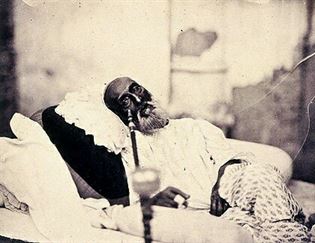A hookah (Persian: قلیان; Hindustani: हुक़्क़ा (Devanagari) حقّہ (Nastaleeq), ḥuqqah, hukkā, Hukić ‒ also known as a waterpipe, narghile, arghila, qalyān, shisha, or by other names) is a single or multi-stemmed instrument for vaporizing and smoking flavored tobacco called shisha in which the vapor or smoke is passed through a water basin ‒ often glass-based ‒ before inhalation.
The origin of the waterpipe is from the time of the Safavid dynasty in the Persian empire which extended into India to where it also spread during that time. The hookah or Argyleh soon reached Egypt and the Levant during the Ottoman dynasty where it became very popular and where the mechanism was later perfected. The word hookah is a derivative of “huqqa”, an Arabic term According to Cyril Elgood (PP.41, 110) it was in India where the physician Hakim Abu’l-Fatḥ Gīlānī (d. 1588), at the court of the Mughal emperor Akbar I (1542 – 1605 AD) invented the idea.Following the Portugese/European introduction of tobacco to India, Hakim Abul Fateh Gilani came from Gilan, a province in the north of Iran, to India. He later became a physician in the court of Mughal and raised concerns after smoking tobacco became popular among Indian noblemen. He subsequently envisaged a system which allowed smoke to be passed through water in order to be ‘purified’.Gilani introduced the ḡalyān after Asad Beg, the ambassador of Bijapur, encouraged Akbar to take up smoking. Following popularity among noblemen, this new device for smoking soon became a status symbol for the Indian aristocracy and gentry.
Source : Wikipedia
The emperor Akbar’s emissary, Asad Beg, Bijapur wrote of his visit: ‘In Bijapur I found some tobacco. Never having seen the like in India, I brought some with me and prepared a handsome pipe of jewelled work’ which he presented to Akbar. He reported that merchants began to sell tobacco, so the habit of smoking quickly spread. Jahangir banned smoking in 1618; but five years later Surat began exporting tobacco.
Jahangir’s Jade hookah, National Museum, New Delhi.
Mumtaz Mahal, consort of Shah Jahan, seated in an interior smoking a hookah, an attendant with a morchal standing behind her Company School, Delhi, circa 1860
Bahadur Shah seems to have been particularly fond of huqqah.


In his last days in Rangoon, no longer an Emperor but a commoner

Emperor Muhammad Shah with four courtiers, smoking huqqah, ca. 1730,
Bodleian Library, University of Oxford
#huqqah
Empress Qudsia Begum earlier Udham Bai entertained
Artist: Mir Miran (1742)
San Diego Museum of Art
“Enjoyment of women” book translated into Persian from Indian text
Some images of women enjoying Huqqah in the medieval age

Some unique huqqahs and their base
A silver and copper huqqah from 1800s
Large Bell-shaped Silver-Inlaid Bidri Hookah Base
Bidar, Deccan, India
19th century
Silver Hookah with Fine, Woven Pipe
India
19th century
Huqqa Base
India, Mughal, c. 1700 -1750
Clear glass with gilding over shaped appliqué glass pieces& blue glass insets
Huqqa Base
India (Bidar), Mughal, 18th century
Nephrite jade with semi precious stones set in gold